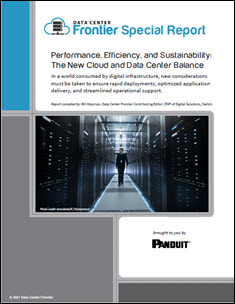Last week we continued our special report series on the new cloud and data center balance. This week we’ll explore solutions for cloud business leaders who are constantly looking to improve their time to market.
Your ability to work within a digital market entirely depends on how you deliver cloud and data center workloads. Today’s markets move at the speed of data. This means that partners need to find ways to be creative, improve customers’ deployment speed and reduce overall times to market.
Whether updating existing systems or planning expansions, the amount of development and implementation rework time can be costly. The ability to deliver decentralized critical cloud infrastructure revolves around the ability to deploy infrastructure quickly. A pre-built building block approach can reduce deployment time up to 75%.
According to the IDG Research Services survey, when planning for data center construction or expansion, companies prioritize scalability/upgradeability (82%). Reducing the risk of deployment (65%) is a critical/high priority for respondents. Consistency of deployment across multiple sites is a critical/ high priority for survey participants. These priorities are expressed against the backdrop of a dynamically growing and evolving data center. As the report points out, reducing the total cost of ownership (TCO) and maintaining network reliability are the top physical infrastructure challenges when building or expanding the data center. More than half (53%) also cite planning for and predicting power and cooling needs.
On that note, predicting things like deployment time, performance, and even latency is critical. Eighty-five percent of respondents cite predictable performance as a critical/high priority. Another essential benefit is assured integration of all physical infrastructure components, with 75% citing this as a critical/high priority. Data center managers appreciate the pre- validation and testing of pre-configured physical infrastructure as it reduces the overall risk of the data center project.
Finally, more than 70% also cite fast, repeatable deployments as a substantial benefit. Survey respondents who rate themselves very likely to leverage a pre-configured approach repeatedly cite the reason to be ease/speed of design/ implementation, consistent design, the lower total cost of ownership, ease in multisite deployment, simpler logistics, and support.
Pre-configured cloud for speed to deploy and time to market
Respondents to the IDG survey indicate the items with the most significant appeal for being pre- configured are cable management (87%); power strips (86%); patch panels (81%); pre-defined, tested racking strategy designed to optimize power, stability, cooling and space (80%); and pre-sized, labeled patch cable kits with cabling instructions (80%). The varying answers suggest that an à la carte method of customizing specific pre-configured components would generate the broadest appeal among potential buyers.
Pre-configured solutions appeal to customers who need to maximize speed and those that need validation and pre- testing that the solution will work as intended. This is about repeatability, consistency, speed to deploy.
Pre-configured physical infrastructures are flexible solutions. For cloud providers, the strategy is to respond to the customer and the overall market needs. The pre-configured solution does facilitate the speed of deployment but does not prevent the ability to tweak according to customer needs. Pre-configured solutions appeal to customers who need to maximize speed and those that need validation and pre-testing that the solution will work as intended. This is about repeatability, consistency, speed to deploy. This is why it’s essential to work with partners that, for example, already have network configurations that customers can repeat as a standalone modular cabinet.
When working with solutions that are aimed explicitly at created repeatability alongside improving your time to market and speed to deployment, look for partners that offer a consultative approach to identify customer needs.
In creating your digital infrastructure balance between the data center and cloud solutions, know that Pre-Configured Physical Infrastructure offerings are based on proven reference architectures that map the logical to the physical layer. These solutions are pre-engineered, tested, and validated to lower the infrastructure speed of deployment, enhance thermal performance, decrease energy usage and reduce TCO, resulting in reduced risk and increased sustainability.
Here’s why this is important to help you keep pace with a digital market.
Safety and security
Validated designs with rigorous testing will consider safety and security before anything is delivered to an end-user. As discussed in a previous section, look for leaders that leverage a Prevention through Design (PtD) approach. This approach utilizes tools and best practices that range from voltage verification processes to safety products that help you reduce your risk posture in a physical facility without impacting your workforce or productivity.
Improving the time to market and speed to deploy
As discussed earlier, leading partners can significantly reduce the amount of time it takes you to deploy market-critical systems. Pre-configured designs that support cloud and data center solutions reduce deployment time by up to 65% and decrease planning time by 80%. This takes the guessing game out of your capability to scale with the market and deploy solutions rapidly.
Improving performance
We all know what an ethernet cable looks like. But they’re certainly not all built the same. For example, the horizontal and patch cable design utilizes UTP Copper Cabling Systems with Advanced MaTriX Technology and advanced connector compensation techniques to achieve channel bandwidth performance above industry standard requirements. This innovative design reduces the weight and diameter of Category 6A UTP cabling, improving pathway capacity up to 30%, resulting in improved airflow through dense data center enclosures without compromising alien crosstalk performance.
Working with networking technologies and improving cabling are all great ways to help reduce latency. Another critical factor is understanding distance and could potentially cause latency.
Reducing latency
Cloud professionals aiming to decentralize large cloud ecosystems must look to emerging data center solutions to help them distribute their solutions and approach a broader market. Working with networking technologies and improving cabling are all great ways to help reduce latency. Another critical factor is understanding distance and could potentially cause latency. For example, the ideal location for the shortest network latency may not be ideal for environmentally delicate equipment and cabling. It may be that the best place to locate the edge computing resources is on a harsh factory floor. This might necessitate ruggedized compute and storage equipment but may impact the networking infrastructure as well. Electromagnetic interference (EMI) may also be a part of a harsh environment.
This might require using shielded copper cabling that has improved immunity to EMI or fiber optic cabling that is entirely immune.
One thing to consider would be deploying environmental sensors to monitor the environment in proximity of the edge computing equipment. Look for partners that offer temperature, humidity, and other sensors as part of an overall IoT Remote Monitoring Sensor Solution.
Reducing complexity
Complexity and fragmentation will slow down innovation and the business. Emerging data center technologies, including virtualization, consolidation, and automation, can add complexity and increase implementation time. Leading partners in the data center and cloud space deliver pre-configured infrastructures that help solve this problem. Further, these pre-validated designs reduce the risks associated with adopting new technologies by optimizing the physical infrastructure to the logical elements of the network.
When you need to go after a market quickly and deploy reliable solutions, you can reduce planning, design, fulfillment, and procurement times, with cloud and data center-ready pre-configured physical infrastructure. Leading solutions can actually include all necessary systems under one part number.
Leading partners will also put all product designs through a ‘Design for Environment’ product lifecycle approach, including operational energy efficiency, end-of-life, and disposal considerations.
Reducing waste
A Unified Physical Infrastructure approach is specifically designed to connect, manage and automate critical systems in an optimized way to save energy, resources, and time. Furthermore, leading partners will also put all product designs through a ‘Design for Environment’ product lifecycle approach, including operational energy efficiency, end-of-life, and disposal considerations.
Select the degree of preconfiguration that makes sense for your application. Work with partners that offer value in the supply chain and use flexible solutions
to accommodate the varying degrees of pre-configuration you choose to employ.
Finally, pre-configured infrastructure can take on many forms and myriad delivery models. Fully configured directly from the factory, prepackaged for onsite assembly and installation, distributor, SI, or other delivery partner enabled. Each end customer and every site are unique, as is your ability to adopt pre-configured solutions. So this is not necessarily an individual component or turn-key solution. Select the degree of preconfiguration that makes sense for your application. Work with partners that offer value in the supply chain and use flexible solutions to accommodate the varying degrees of pre-configuration you choose to employ. It’s not all or nothing; it’s all and nothing!
Download the full report, “Performance, Efficiency, and Sustainability: The New Cloud and Data Center Balance” courtesy of Panduit to learn more about how the new cloud and data center balance. In our next article, we’ll discuss how efficiency, reliability, and the future of digital infrastructure will be impacting your market strategies. Catch up on previous articles here and here.







